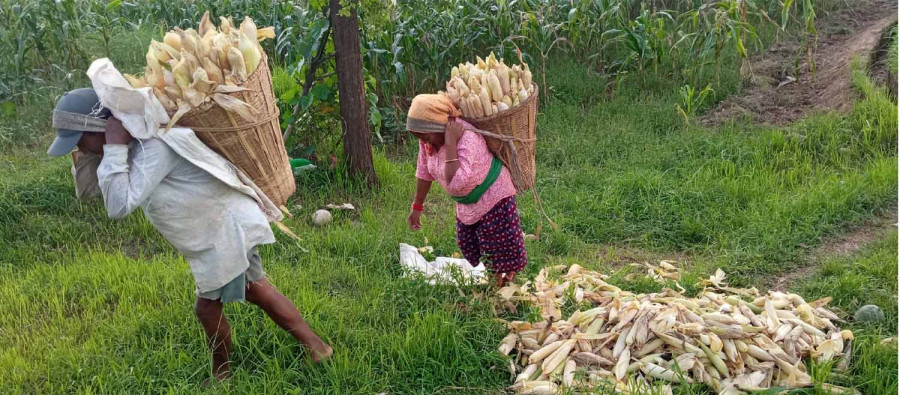Money
Farmers receive credit cards to buy farm inputs
The cards issued to farmers in Diktel Rupakot Majhuwagadhi Municipality, Khotang have a credit limit of Rs200,000.
Dambar Singh Rai
A municipality in Khotang district in eastern Nepal has started issuing credit cards to farmers to buy farm inputs in a bid to encourage commercial farming.
The interest on the credit card is subsidised by the federal and local governments, so the farmers pay only a small charge.
Tirtha Raj Bhattarai, mayor of Diktel Rupakot Majhuwagadhi Municipality, said they were issuing subsidised loans of Rs200,000 each to all farmers.
“The scheme will help them financially and technically,” he said.
According to Bhattarai, farmers can use the credit card to buy chemical fertilisers, seeds and agricultural tools from agro vets, stores and cooperatives.
The cards cannot be used to withdraw cash from banks.
“The scheme will benefit farmers who wish to go into commercial farming,” said Bhattarai.
The credit card scheme is a joint initiative of Global IME Bank, R&D Innovative Solution and the municipality.
As per the plan, Global IME Bank will provide a Rs200,000 loan each for a period of five years to farmers enrolled in the scheme.
The federal government and the municipality will each provide an interest rate subsidy of 5 percent. R&D Innovative Solution will provide training to the farmers.
Bishal Rai, deputy mayor of Diktel Rupakot Majhuwagadhi Municipality, said the first batch of 21 farmers who applied for the loan have received the credit card.
“All the farmers in the municipality will be included in the scheme gradually,” said Rai.
The objective of the credit card is to reduce farmers' dependence on informal credit. To that end, recent initiatives have been focused explicitly on rural areas and have had a positive impact on the flow of agricultural credit, municipality officials said.
According to the officials, the credit card scheme will prevent misappropriation of subsidised loans.
The federal government is preparing to scrap the subsidised interest loan programme amid criticism that it has been misused and has not reached the target group.
A study report of Nepal Rastra Bank shows that loans disbursed through the subsidised loan programme have been invested in non-productive sectors such as real estate and motor vehicles.
The report said that as banks and financial institutions were not accountable, the loans designated for the productive sector did not reach a majority of the target group.
The scheme was launched under the Consolidated Procedure on Interest Subsidy for Concessional Loans by the Ministry of Finance in 2018.
Nepal Rastra Bank has said it will assess the usefulness and effectiveness of the scheme.
Diktel Rupakot Majhuwagadhi Municipality, which consists of 15 wards, has said the credit card scheme will benefit farmers wanting to go into commercial farming as there are fewer chances of misappropriation.
The municipality is preparing to implement a one-ward, one-product scheme to boost agricultural production by creating pocket zones.
It has also been distributing saplings of improved varieties of fruits. Kiwi, coffee, seasonal vegetables and dairy products are the main products of the region.
All 10 local units in the district have prioritised commercial agriculture to boost farm incomes.
“Some local governments have also made plans to process agricultural products for greater marketability,” said Rai.
Despite the introduction of a subsidised interest credit programme by the government in 2014, farmers say commercial banks are reluctant to provide loans to small farmers citing various constraints.
There is also another window of concessional loans that targeted sectors receive.
Initially, interest subsidies were given for seven types of loans, including agriculture and livestock, educated youth self-employment, youths returning from abroad, women entrepreneurs, Dalit community business development, higher and technical and vocational education, and private housing construction loans for earthquake victims.
The concessional loan under the interest subsidy programme of the government was provided to 147,510 borrowers with an outstanding amount of Rs203.10 billion in mid-June 2023, according to Nepal Rastra Bank.
Out of the total lending of commercial banks, 13.1 percent (Rs552.99 billion) had been in the agriculture sector as of mid-June 2023.
Development banks had extended 24.9 percent (Rs113.18 billion) and finance companies 22.3 percent (Rs19.65 billion loans) of their loans in the agriculture, micro, cottage and small enterprises, energy and tourism sectors as of mid-June 2023.
As per a new directive, banks and financial institutions are required to increase their lending to the agriculture sector to 15 percent by mid-July 2025. The previous deadline was mid-July 2023.




 9.12°C Kathmandu
9.12°C Kathmandu














